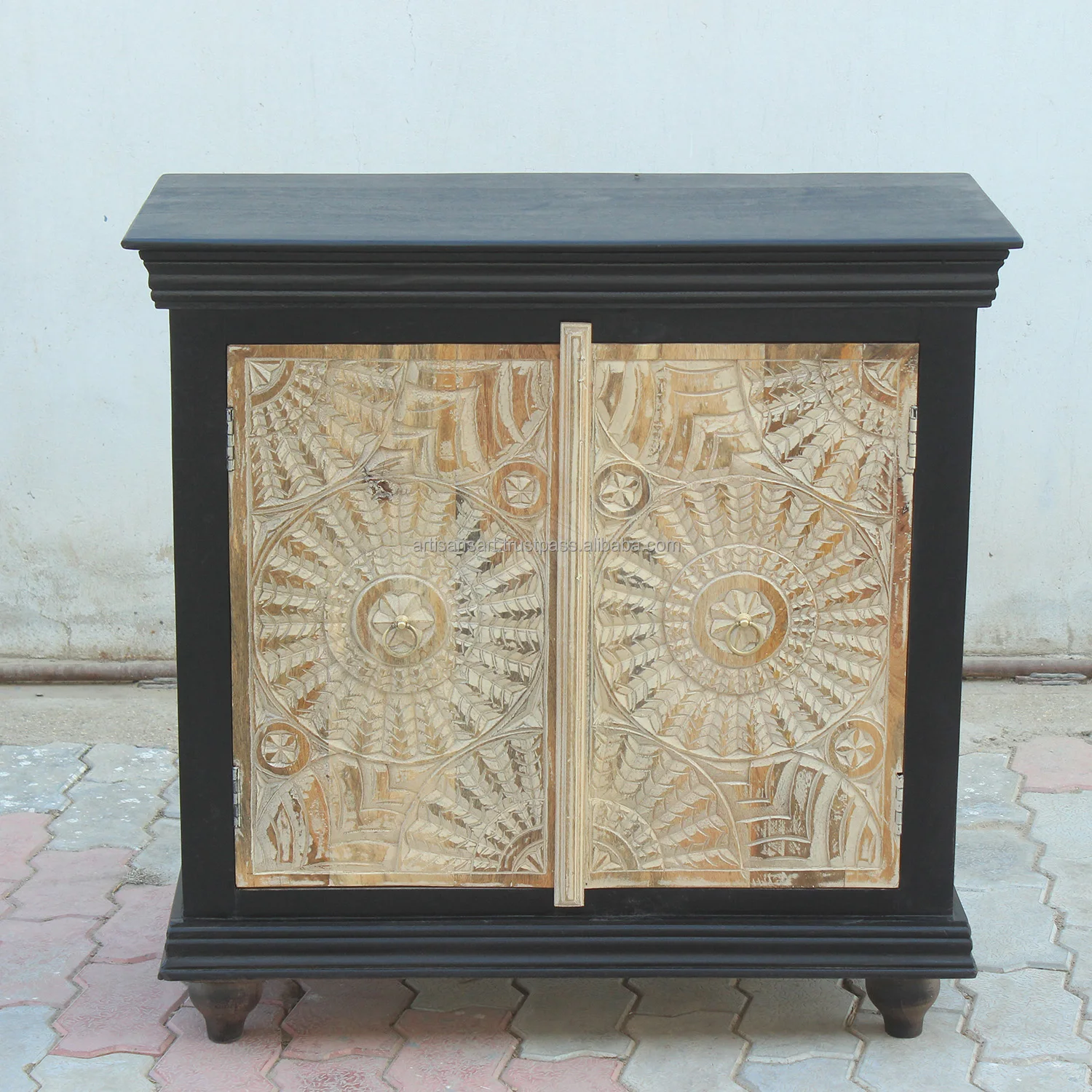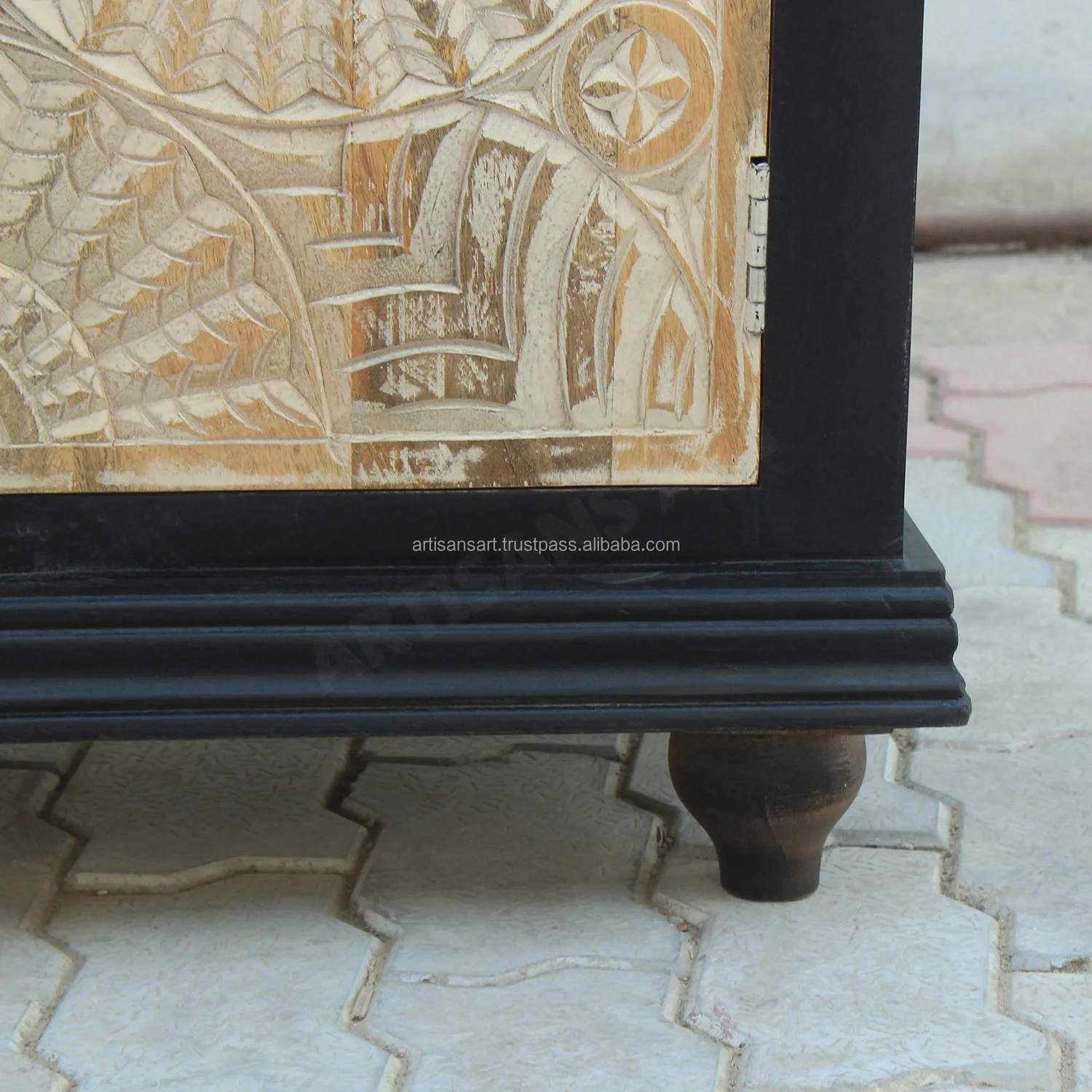The Appeal of Carved Wood Accent Cabinets

Carved wood accent cabinets offer a unique blend of aesthetic beauty and functional utility, making them a captivating addition to any home. These cabinets, with their intricate carvings and rich wood tones, transform a simple storage solution into a statement piece that reflects the homeowner’s taste and style.
Aesthetic Benefits of Carved Wood Accent Cabinets
The intricate carvings on these cabinets are not merely decorative elements; they are artistic expressions that add depth and dimension to the piece. The craftsmanship involved in creating these carvings is evident in the meticulous detail and the fluidity of the design. The wood itself, often chosen for its rich grain and warm hues, complements the carvings, creating a harmonious visual experience.
Functional Benefits of Carved Wood Accent Cabinets
Beyond their aesthetic appeal, carved wood accent cabinets provide practical storage solutions. They offer a versatile space to display cherished items, organize books, or store household essentials. The closed compartments and drawers ensure that items are protected from dust and damage, while the open shelves provide a platform for showcasing decorative objects.
Historical Significance and Cultural Influences of Carved Wood Furniture
Carved wood furniture has a long and rich history, dating back to ancient civilizations. In many cultures, wood carving was considered an art form, and the intricate designs often reflected religious beliefs, social status, and cultural traditions.
- In ancient Egypt, carved wood furniture was used in tombs and temples, often depicting scenes from mythology and daily life.
- In China, carved wood furniture was highly prized for its craftsmanship and artistry, with intricate designs inspired by nature, mythology, and traditional Chinese motifs.
- In Europe, during the Renaissance period, carved wood furniture became increasingly elaborate, with ornate designs inspired by classical mythology and the human form.
Different Wood Carving Styles and Their Unique Characteristics
Wood carving styles vary widely across different cultures and periods, each with its own unique characteristics and aesthetic appeal.
- Relief Carving: This style involves carving a design into the surface of the wood, leaving the design raised from the background.
- Intaglio Carving: This style involves carving a design into the surface of the wood, leaving the design recessed into the background.
- Chip Carving: This style involves using a sharp knife to create a series of small, interlocking chips in the wood, creating a geometric pattern.
- Whittling: This style involves using a knife to carve a design into a piece of wood, often creating rounded shapes and smooth curves.
Choosing the Right Carved Wood Accent Cabinet

Selecting the perfect carved wood accent cabinet involves considering your room’s size, existing décor, and the cabinet’s style and finish. It’s about finding a piece that complements your space and enhances its aesthetic appeal.
Determining the Right Size
The size of the accent cabinet is crucial for its visual impact and functionality. Too large, and it can overwhelm the room; too small, and it might get lost. Measure the available space where you intend to place the cabinet, considering its height, width, and depth. Take into account the surrounding furniture and ensure enough clearance for easy access and movement.
Choosing the Right Style
Carved wood accent cabinets come in a variety of styles, from traditional to contemporary. Consider the overall aesthetic of your room and choose a style that complements it. For example, a classic Victorian room might suit a cabinet with intricate floral carvings, while a modern minimalist space could benefit from a sleek, geometric design.
Selecting the Right Finish
The finish of a carved wood accent cabinet significantly impacts its overall look and feel. Natural wood finishes offer a warm and inviting ambiance, while painted finishes can add a touch of color and personality. Consider the existing color palette of your room and choose a finish that complements it. A dark wood finish can create a sense of sophistication and formality, while a light wood finish can brighten up a space.
Wood Types and Their Suitability for Carving
The type of wood used for a carved wood accent cabinet influences its durability, appearance, and carving properties.
| Wood Type | Properties | Suitability for Carving |
|---|---|---|
| Mahogany | Strong, durable, rich color | Excellent, holds intricate details well |
| Oak | Hard, strong, distinctive grain | Good, but requires sharp tools |
| Cherry | Hard, beautiful grain, rich color | Good, but can be slightly brittle |
| Walnut | Strong, beautiful grain, dark color | Good, but can be dense and require effort |
| Pine | Soft, lightweight, affordable | Easy to carve, but not as durable |
Measuring and Planning Cabinet Placement
Precise measurements and planning are crucial for successful cabinet placement.
- Measure the available space: Determine the height, width, and depth of the area where you intend to place the cabinet. Consider the surrounding furniture and ensure enough clearance for easy access and movement.
- Consider the cabinet’s dimensions: Ensure the cabinet’s size fits comfortably within the available space. Take into account its height, width, and depth, and leave enough clearance around it for visual balance and functionality.
- Visualize the cabinet’s placement: Use a tape measure or painter’s tape to mark the intended location of the cabinet on the floor. Step back and observe the placement from different angles to ensure it looks visually appealing and doesn’t obstruct any pathways or furniture.
- Consider lighting: Ensure the cabinet’s placement allows for adequate lighting. If necessary, adjust the lighting fixtures or use additional lamps to highlight the cabinet’s beauty.
- Finalize the placement: Once you are satisfied with the placement, carefully move the cabinet into its designated location. Make sure it is level and secure.
Styling and Displaying a Carved Wood Accent Cabinet

A carved wood accent cabinet is more than just storage; it’s a statement piece that adds character and visual interest to any room. Styling and displaying your cabinet effectively will enhance its beauty and showcase your personal taste.
Decorative Items that Complement Carved Wood Accents
The right decorative items can elevate the beauty of your carved wood accent cabinet. Choose pieces that complement the wood’s natural warmth and intricate carvings.
- Vases: Ceramic vases in earthy tones like terracotta or cream, or those with geometric patterns, create a harmonious look.
- Sculptures: Abstract sculptures in bronze, wood, or stone add a touch of modern sophistication.
- Books: Stacking leather-bound books or those with interesting covers adds visual texture and creates a sense of history.
- Plants: A small potted succulent or a trailing vine can bring a touch of nature and life to the cabinet.
- Candles: Scented candles in glass jars or elegant candle holders add a warm ambiance and create a focal point.
Arranging and Displaying Items on a Carved Wood Accent Cabinet
Arranging items on your cabinet involves creating visual balance and flow.
- Symmetry: For a formal look, arrange items symmetrically on either side of the cabinet’s center. This creates a sense of order and balance.
- Asymmetry: For a more casual and eclectic feel, experiment with asymmetrical arrangements. This can involve placing items of varying heights and shapes in a way that feels visually appealing.
- Height and Depth: Vary the heights of items to create visual interest. Place taller items in the back and shorter items in the front.
- Negative Space: Don’t overcrowd the cabinet. Leave some negative space between items to allow them to breathe and create a sense of visual balance.
- Color Harmony: Choose items in colors that complement the wood’s natural tones. Earthy tones, metallic accents, and pops of color can all work well.
Using a Carved Wood Accent Cabinet to Create a Focal Point
A carved wood accent cabinet can become the focal point of a room.
- Placement: Position the cabinet in a prominent location, such as against a blank wall or in a corner.
- Lighting: Use accent lighting to highlight the cabinet’s intricate carvings and showcase the displayed items.
- Color Contrast: Paint the wall behind the cabinet in a contrasting color to make it stand out.
- Mirror Reflection: Place a mirror near the cabinet to reflect light and create a sense of spaciousness.
The carved wood accent cabinet stood silent, its intricate details whispering secrets of a forgotten past. Its aged wood, smooth from years of touch, seemed to hold a memory of another time, a time before the sleek, modern lines of plastic bathroom cabinets online india took center stage.
Yet, within its depths, a sense of anticipation lingered, as if the cabinet itself was waiting for a new story to unfold.
The carved wood accent cabinet, with its intricate details and aged patina, seemed to whisper secrets of a bygone era. Its presence in the modern bathroom, however, felt oddly out of place, a stark contrast to the sleek lines and minimalist design of the all modern bathroom cabinets that surrounded it.
One couldn’t help but wonder what stories lay hidden within the cabinet’s depths, perhaps tales of forgotten rituals and whispered wishes, remnants of a time when the bathroom was a place of mystery and intrigue.
